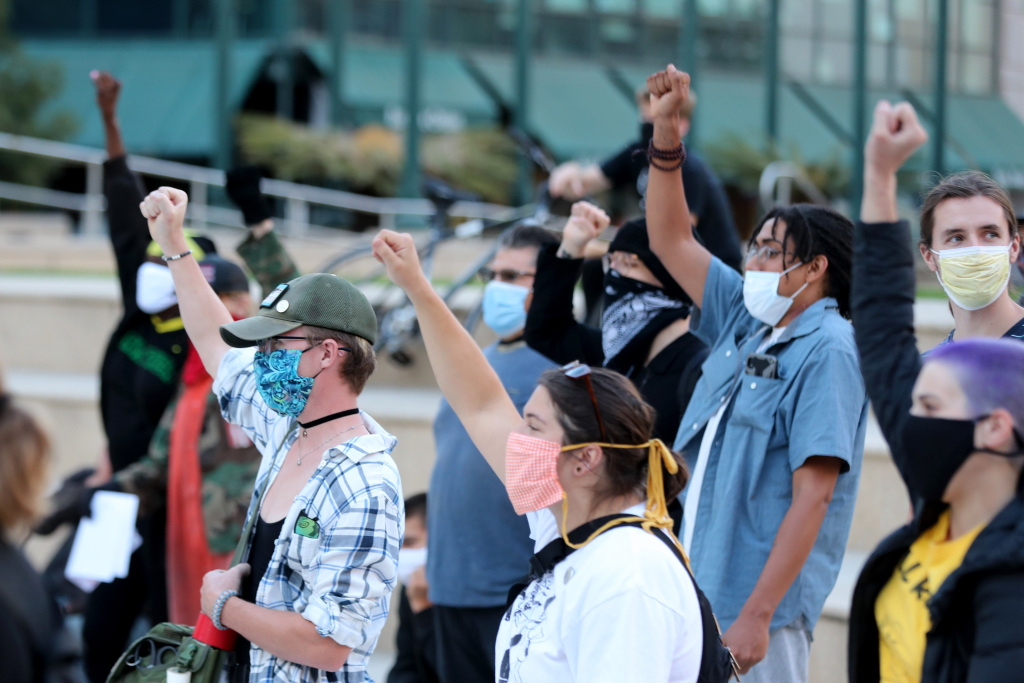Oakland City Council passed controversial new rules Tuesday night that dictate where homeless residents can and can’t camp — and how they must camp — in an effort to get a handle on a crisis spiraling out of control in the city.
The policy makes certain areas near schools, homes and businesses mostly off-limits to encampments, and lays out steps to move residents living there into housing or shelters and shut down the camps. After more than 100 community members weighed in — mostly in opposition — during a passionate public comment session that lasted hours, City Council voted unanimously to approve the new policy.
The move represents the city’s first attempt to craft a set of sweeping rules to govern its unsheltered communities. It comes as camps that sprawl across sidewalks, parks and vacant lots have pushed many Oaklanders to their breaking point. City officials are aware of 142 encampments throughout Oakland — about 70 of which have three or more residents — and many of which city staff says have become unsanitary and violent.
“There’s a need for us to at the very least create some standards by which we are providing public safety, public health measures for people who are living in encampments,” Homelessness Administrator Daryel Dunston said during the virtual council meeting. “This isn’t to criminalize folks. This is to say if you’re going to live here, let’s establish some basic standards to protect your own safety.”
Many community members who dialed into the meeting decried the policy as an inhumane move to wall off sections of Oakland against homeless residents, and the proposal sparked protests Tuesday night in front of City Hall and outside Councilman Dan Kalb’s home. But others called it a necessary step to manage encampments that have made certain blocks unlivable for housed residents.
From outside CM Kalb’s house – one of our two demonstrations to #StopEMP! #HomelessnessIsNotACrime #UpgradeDontEvict pic.twitter.com/MEerSOix2w
— The Village, Oakland (@VillageOakland) October 21, 2020
The new policy prioritizes clearing encampments from “high-sensitivity” areas, including those within 150 feet of an elementary or middle school, within 50 feet of a residence, business, public park or protected waterway, and within 25 feet of a homeless shelter. Encampments in other areas will be let be, as long as they follow certain rules. Residents may not camp on both sides of a street, store flammable materials or take up more than 12 square feet per person.
The city will start removing encampments in off-limits areas in January, despite the ongoing coronavirus pandemic. Following federal guidelines to reduce the spread of COVID-19, Oakland officials had suspended camp sweeps earlier this year.
Councilmembers pushed Tuesday to create options for residents displaced during encampment closures. Councilwoman Lynette Gibson McElhaney added an amendment that requires city staff to identify land in all seven districts for sanctioned encampments. Councilwoman Nikki Fortunato Bas added language that forces the city to set up a sanctioned encampment within the next four months that would be run jointly by unhoused residents and a local nonprofit.
In order to provide services to all homeless residents relocated under the new plan, the city will work to double its outreach capacity and launch a second public works crew dedicated to encampment clean-ups, Dunston said. The city also will establish a database to track the status of each encampment, and develop a mobile app outreach workers can use to report on camp conditions in real-time.
But Oakland has about 1,000 shelter and interim housing beds — not nearly enough to accommodate the city’s more than 4,000 unhoused residents.
Opponents of the new plan faulted city officials for failing to take the needs of homeless people into account. When staffers surveyed Oakland residents for feedback on the proposed policy earlier this year, 14% of participants were unhoused.
And they worried that by breaking up existing encampments, the city will put unhoused people at a greater risk of contracting COVID-19.
“This policy violates the human rights of the unhoused,” said Darrell Jones III, deputy director of activist group Just Cities. “It violates the agreed-upon COVID standards that we passed at the outset of this.”
Several lawyers also warned the policy could lead to litigation. They argued it would violate an appellate decision from the Ninth Circuit, which states cities cannot penalize unhoused people for sleeping outside on public property if no other shelter is available. Dunston said the policy is legally sound.
Councilman Noel Gallo said he was troubled by the extent of the backlash against the policy, and indicated he wanted to get more feedback from the community — including unhoused residents — before pushing it through. But he ended up voting for it anyway.
Other community members urged City Council to pass the policy.
Anand Patel, a business owner who lives next to an encampment in Oakland, said he’s sick of cleaning up human feces and throwing away other people’s garbage outside his home.
“We understand that the unhoused should not have to live on the street and in these conditions,” Patel said. “At the same time, homeowners and business owners are also being affected by this crisis. We cannot allow this lawlessness of people using people’s yards as bathrooms, garbage dumps…We cannot allow this to continue.”
Scott West, a resident of Oakland’s Adams Point neighborhood, said an encampment by his home is so noisy he can’t sleep or work, and so dirty it’s a health hazard. He urged City Council to pass rules regulating the camps.
“If we don’t do that,” he said, “we’re only going to reach a tipping point in which the housed start leaving Oakland.”










